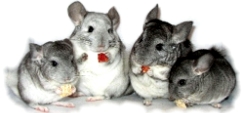1
General Breeder Chat / Re: TOV ebony?
« on: March 21, 2010, 11:35:52 PM »It is important to be sure there is Ebony in the background of a chinchilla sold as a "TOV Ebony". When breeding for the very dark veiling all the way to the white belly you can have some dirty belly babies born. These could be mistaken for Ebony but are not.
I've seen that in heavily veiled animals also. The veiling extends so far it causes ticking on the bellies.
I have attached a couple picture of my boy who is a TOV eb... although I normally just refer to him as a black velvet for simplicity's sake because you can't see the eb influence unless you look at his belly. He is not a breeding animal - just a sweetie pet boy. He has ebony in his ped two generations back. However, the ebony influence is very light. I will have to get a picture of his chest though because all the pictures I have are of his face, side, or front-facing without a clear view of his chest and belly area.





